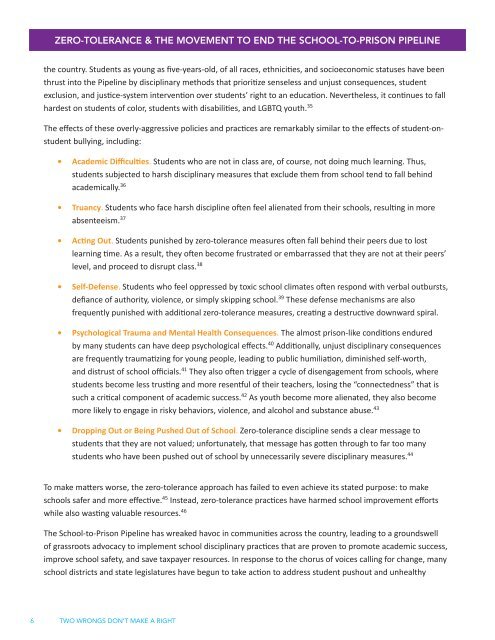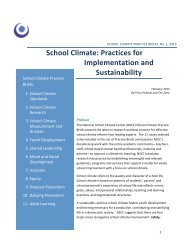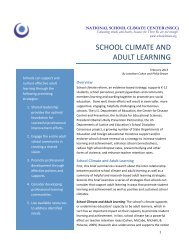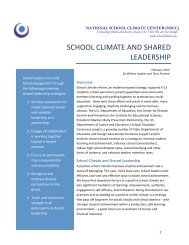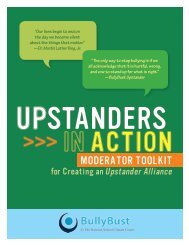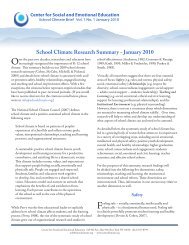two wrongs don't make a right - National School Climate Center
two wrongs don't make a right - National School Climate Center
two wrongs don't make a right - National School Climate Center
You also want an ePaper? Increase the reach of your titles
YUMPU automatically turns print PDFs into web optimized ePapers that Google loves.
ZERO-TOLERANCE & THE MOVEMENT TO END THE SCHOOL-TO-PRISON PIPELINE<br />
the country. Students as young as five-years-old, of all races, ethnicities, and socioeconomic statuses have been<br />
thrust into the Pipeline by disciplinary methods that prioritize senseless and unjust consequences, student<br />
exclusion, and justice-system intervention over students’ <strong>right</strong> to an education. Nevertheless, it continues to fall<br />
hardest on students of color, students with disabilities, and LGBTQ youth. 35<br />
The effects of these overly-aggressive policies and practices are remarkably similar to the effects of student-onstudent<br />
bullying, including:<br />
• Academic Difficulties. Students who are not in class are, of course, not doing much learning. Thus,<br />
students subjected to harsh disciplinary measures that exclude them from school tend to fall behind<br />
academically. 36<br />
• Truancy. Students who face harsh discipline often feel alienated from their schools, resulting in more<br />
absenteeism. 37<br />
• Acting Out. Students punished by zero-tolerance measures often fall behind their peers due to lost<br />
learning time. As a result, they often become frustrated or embarrassed that they are not at their peers’<br />
level, and proceed to disrupt class. 38<br />
• Self-Defense. Students who feel oppressed by toxic school climates often respond with verbal outbursts,<br />
defiance of authority, violence, or simply skipping school. 39 These defense mechanisms are also<br />
frequently punished with additional zero-tolerance measures, creating a destructive downward spiral.<br />
• Psychological Trauma and Mental Health Consequences. The almost prison-like conditions endured<br />
by many students can have deep psychological effects. 40 Additionally, unjust disciplinary consequences<br />
are frequently traumatizing for young people, leading to public humiliation, diminished self-worth,<br />
and distrust of school officials. 41 They also often trigger a cycle of disengagement from schools, where<br />
students become less trusting and more resentful of their teachers, losing the “connectedness” that is<br />
such a critical component of academic success. 42 As youth become more alienated, they also become<br />
more likely to engage in risky behaviors, violence, and alcohol and substance abuse. 43<br />
• Dropping Out or Being Pushed Out of <strong>School</strong>. Zero-tolerance discipline sends a clear message to<br />
students that they are not valued; unfortunately, that message has gotten through to far too many<br />
students who have been pushed out of school by unnecessarily severe disciplinary measures. 44<br />
To <strong>make</strong> matters worse, the zero-tolerance approach has failed to even achieve its stated purpose: to <strong>make</strong><br />
schools safer and more effective. 45 Instead, zero-tolerance practices have harmed school improvement efforts<br />
while also wasting valuable resources. 46<br />
The <strong>School</strong>-to-Prison Pipeline has wreaked havoc in communities across the country, leading to a groundswell<br />
of grassroots advocacy to implement school disciplinary practices that are proven to promote academic success,<br />
improve school safety, and save taxpayer resources. In response to the chorus of voices calling for change, many<br />
school districts and state legislatures have begun to take action to address student pushout and unhealthy<br />
6 TWO WRONGS DON’T MAKE A RIGHT


